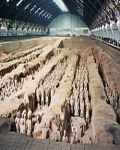Terracotta Army
Archaeology »
Archaeological Monuments » Terracotta Army
Terracotta Army -
Terracotta Army is located in Lintong District, Xi'an,.
Terracotta Army monument was established on 1974.
Primary threats to Terracotta Army :
Historical facts of Terracotta Army :
- The Terracotta Army is one of the most extraordinary archaeological discoveries in history, a vast collection of life-sized clay figures that guards the tomb of China's first emperor, Qin Shi Huang. Unearthed in 1974 near the city of Xi'an in the Shaanxi province of China, the Terracotta Army has captivated the world with its scale, craftsmanship, and historical significance. Here are some historical facts about this remarkable archaeological wonder:
- Purpose and Discovery :
The Terracotta Army was created to protect and accompany the first emperor of China, Qin Shi Huang, in the afterlife. Emperor Qin, who unified China and established the Qin Dynasty (221-206 BC), was obsessed with achieving immortality and preparing for the afterlife. Consequently, he commissioned the construction of an elaborate burial complex that included the Terracotta Army, which consisted of soldiers, chariots, horses, and other figures.
- The discovery of the Terracotta Army took place in March 1974 when local farmers accidentally stumbled upon the site while digging a well. Archaeologists were quickly called in to investigate, leading to the unearthing of one of the most significant archaeological finds of the 20th century.
- Scale and Numbers :
The scale of the Terracotta Army is staggering. It is estimated that there are over 8,000 individual life-sized clay figures in three main pits at the site. These figures include soldiers, archers, charioteers, and even high-ranking officers. Each warrior is unique, and they were likely based on real soldiers from the time of Qin Shi Huang.
- In addition to the warriors, the pits also contain around 130 chariots with 520 horses and more than 150 cavalry horses. The army was arranged in battle formation, facing eastward, symbolizing the protection of the emperor's realm.
- Artistic Craftsmanship :
The craftsmanship and attention to detail exhibited in the Terracotta Army are exceptional. Each figure was individually sculpted with remarkable precision, and their facial features, hairstyles, armor, and clothing were carefully crafted to represent the diversity of the ancient Chinese army.
- The figures were made using a combination of molds for standard parts and individual hand sculpting to add unique characteristics. The skill of the artisans in creating such a vast and accurate assembly of soldiers is a testament to the artistic and technical achievements of ancient China.
- Historical Insights :
The Terracotta Army provides invaluable insights into the military, social, and cultural aspects of ancient China during the Qin Dynasty. The figures offer a glimpse into the weaponry, armor, and military strategies of the time, as well as the diverse ranks and roles within the army.
- The discovery of the Terracotta Army also shed light on the elaborate funeral practices and beliefs of the ancient Chinese rulers. It revealed the significance placed on the afterlife and the lengths to which the emperor went to ensure his protection and prestige in eternity.
- Ongoing Archaeological Work :
The excavation and restoration of the Terracotta Army site have been ongoing since its discovery in 1974. Archaeologists continue to uncover new figures and artifacts, as well as working to preserve and protect the existing ones.
- The site has been developed into a museum complex, known as the Emperor Qinshihuang's Mausoleum Site Museum, attracting millions of visitors from around the world annually.
- Conclusion :
The Terracotta Army is an unparalleled archaeological wonder that offers a glimpse into the ancient history, culture, and military might of China's Qin Dynasty. Its discovery has not only captivated the world but has also significantly enriched our understanding of ancient Chinese civilization. The terracotta soldiers, with their individuality and lifelike representation, stand as a lasting testament to the power and vision of Emperor Qin Shi Huang and the remarkable achievements of ancient Chinese craftsmanship.

